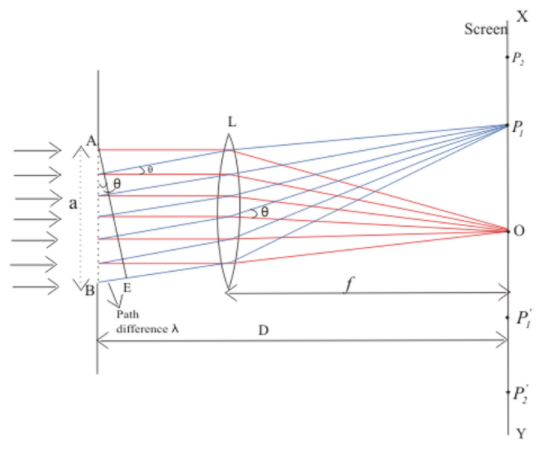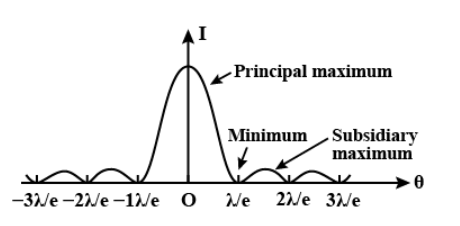
Show graphically the intensity distribution in Fraunhofer’s single slit diffraction experiment. Label the axes.
Answer
570k+ views
Hint: When light passes through a single slit whose width ‘w’ is on the order of the wavelength of the light, then we can observe a single slit diffraction pattern on a screen that is a distance L away from the slit.
Complete answer:
Single slit diffraction is observed when light passes through a single slit whose width is in the order of the wavelength of the light. Diffraction of light is defined as the bending of the light around the corners such that it spreads out and illuminates areas where a shadow is expected. Since, diffraction and interference both occur simultaneously it is hard to separate them.

Let us assume that a parallel beam of light incident on a slit AB of width ‘a’ which is of order f the wavelength of light as shown in the figure. A real image of diffraction pattern is formed on the screen with the help of converging lenses placed in the path of the diffracted beam. All the rays which start from the slit AB in the same phase and produce brightness at point O on the axis of slit as they arrive in the same phase. Thus, the diffraction pattern on screen consists of a central bright band and alternate dark and bright bands of decreasing intensity on both sides.

Hence, the above figure is the required graphical representation of variation of the intensity distribution with their distance from the centre of the central maxima.
Note:
Intensity of these secondary maxima is much less than central maxima and falls off as rapidly as it moves outwards. The central maxima lies between the minima and the width of the central maximum is the distance between the first order minima from the centre of the screen on both the sides of the centre.
Complete answer:
Single slit diffraction is observed when light passes through a single slit whose width is in the order of the wavelength of the light. Diffraction of light is defined as the bending of the light around the corners such that it spreads out and illuminates areas where a shadow is expected. Since, diffraction and interference both occur simultaneously it is hard to separate them.

Let us assume that a parallel beam of light incident on a slit AB of width ‘a’ which is of order f the wavelength of light as shown in the figure. A real image of diffraction pattern is formed on the screen with the help of converging lenses placed in the path of the diffracted beam. All the rays which start from the slit AB in the same phase and produce brightness at point O on the axis of slit as they arrive in the same phase. Thus, the diffraction pattern on screen consists of a central bright band and alternate dark and bright bands of decreasing intensity on both sides.

Hence, the above figure is the required graphical representation of variation of the intensity distribution with their distance from the centre of the central maxima.
Note:
Intensity of these secondary maxima is much less than central maxima and falls off as rapidly as it moves outwards. The central maxima lies between the minima and the width of the central maximum is the distance between the first order minima from the centre of the screen on both the sides of the centre.
Recently Updated Pages
Why are manures considered better than fertilizers class 11 biology CBSE

Find the coordinates of the midpoint of the line segment class 11 maths CBSE

Distinguish between static friction limiting friction class 11 physics CBSE

The Chairman of the constituent Assembly was A Jawaharlal class 11 social science CBSE

The first National Commission on Labour NCL submitted class 11 social science CBSE

Number of all subshell of n + l 7 is A 4 B 5 C 6 D class 11 chemistry CBSE

Trending doubts
What is meant by exothermic and endothermic reactions class 11 chemistry CBSE

10 examples of friction in our daily life

One Metric ton is equal to kg A 10000 B 1000 C 100 class 11 physics CBSE

1 Quintal is equal to a 110 kg b 10 kg c 100kg d 1000 class 11 physics CBSE

Difference Between Prokaryotic Cells and Eukaryotic Cells

What are Quantum numbers Explain the quantum number class 11 chemistry CBSE




